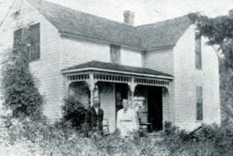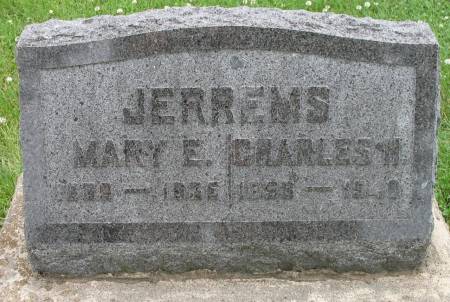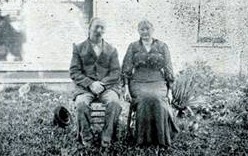Dear Donald,
| Remember Me – Charles Jerrems |
Ray Jerrems with Research by Sandra Walcyk
TBA

Introduction
This article is one of the “Remember Me” series and
tells you about Charles Jerrems, who was born in
1858 in the Utica area in New York State. His
ancestors came from Wappenham, described in the
JJ of February 2008.
A distinguishing feature of the “Remember Me”
articles is that we have located a photograph of the
person described.
Much of the information in this article originated from
research by Sandra, supplemented by my research.
Charles’ Parents and Siblings
Charles’ parents were James Jerrems and his
second wife Esther Jerrems (nee Colbrook).
Charles came from a large “extended family”. As
described in the JJ of July 2008, James and first wife
Ann had 8 children James H, Thomas W., Jessee or
Jesse, Elizabeth, Josephine, Rebecca, Emma and
Helen. The 3 boys served in the Civil War. Following
Ann’s death James married the widowed Esther
in1853 and in due course they had five children, Mary,
born 1853, Anah born 1854 (died 1856), George, born
1856 (died 1859), and lastly our hero Charles, born
1858.
James’s third (and final) wife was the widowed
Caroline Mayborn, who was born in England in 1822.
They had one daughter, Minnie.
Charles’ s Perambulations
The family’s travels remind me of Lucky Starr’s
song “I’ve Been Everywhere”.
Initially Charles lived in New Hartford (near Utica),
where he was born, and then the family moved west to
Essex in Illinois. In 1870 he lived in Akron, Illinois
(about 200 km west of Essex) with his father,
stepmother Caroline and his half sisters Emma, Mary
and Minnie.
In 1880 James, Caroline and Minnie returned to the
Essex area with Minnie only, so Charles (aged 22)
had parted company with his family by that time.
Most of James’s sons had been farmers, so it is likely
that Charles started off working on farms and later
bought a farm. He married Mary Elizabeth Lyons
b1860 in Pennsylvania (whose Irish-born parents
were Cornelius Lyons & Helen Cronon) in about
1880
Charles and Mary then spent their married life
steadfastly in Iowa, where they merrily moved around
comparatively frequently, zig-zagging their way up and
down the State as follows: (a) in 1885 they lived in
Lincoln (near the northern border of the State) (b) in
1891 they lived in Coin (where William was born),
which is near the southern border 224 miles from
Lincoln (c) they moved north 112 miles to Liberty for
the 1900 Census (with their teenage daughters
Caroline, Catherine, Hellena and young William) and
the 1910 Censuses (with late-teenage William only)
(d) they continued their progress towards the Equator
with a period at Mt Ayr (65 miles to the south of Liberty,
near the southern border of Iowa) as seen in the
photographs, then (e) the 1920 Census shows them
taking a minor deviation in a northerly direction by
living alone in Main Street, Tingley (12 miles north of
Mt Ayr), where at long last they finally retired and
stayed until their respective deaths in 1935 (Mary aged
75) and 1940 (Charles aged 82). They now reside in
Tingley Cemetery and, as far as I know, have not
moved from there.
There were numerous railway lines in Iowa. Coin,
Shenandoah, Lincoln and Mt Ayr were on railway lines,
but Liberty and Tingley were not, but they were not far
from railway lines (about 15 miles). It is therefore likely
that the family travelled by rail in its perambulations.
Iowa
Iowa is a mid-western State to the west of the State of
Illinois. It has a higher ratio of rural citizens than most
States and its fertile plains give it a strong agricultural
base (it is known as one of the food bowls of the US),
particularly the growing of crops (predominantly corn)
and raising of animals such as cattle and pigs (known
as hogs in the US). It produces about a quarter of the
hogs in the US.
Education, Financial Position
The 1925 Iowa Census shows that Charles
completed rural high school up to “Reader 6”, the
highest grading being “Reader 8”, so he probably
attended about 3 years of high school. This was a
good standard for a person born in a rural area in the
1850s. Mary completed high school, and attended
university or college for one year. It would have been
quite exceptional for a woman born in the 1860s to
achieve this level.
The Census shows the value of their house at Tingley
to be $3,800, without a mortgage (they were 67 and 66
at this stage). Comparing this with other house values
shown in the Census this would have been a big
house, even though only Charles and Mary lived in it.
In the 1930 Federal Census Charles had reduced his
estimate of the value of his house to $3,000, probably
as the result of the Great Depression, which was
taking hold on the United States.
My conclusion is that they were in a
financially “comfortable” position, irrespective of which
value was correct.
Children
Charles and Mary had 4 children, Caroline (“Callie”) E.
Jerrems b1881 , Katherine (“Kate”) M. Jerrems b1883,
Helena/ Lena Faye Jerrems 1886 – 1931 and William
Cornelius Jerrems 1891 – 1926.
William Cornelius Jerrems
Although I have a lot of information about his sisters
and their descendants I will concentrate on William
because we have a photograph of his grave. He was
born in 1891, in Coin, Iowa. A farmer like his father, he
married Vera George, whose parents were Charles
George & Cornie Zachary, and he died in 1926 at the
early age of 35. William and Vera had 3 daughters (1)
Kathryn Belle (“Belle”) who was born in 1916, and
died in 1991. Belle’s first marriage was to Thomas
Wilfong in about 1932 and they had two sons, William
Thomas Wilfong (b 1934 in Shenandoah, Iowa,
married Marian Jean Hilty) and Robert Wilfong (b. ?).
Second marriage to Morehouse. (2)Helen 1917-1993
(married Kolb) and (3) Mary (1918-1993??) mBattles.
Having had 3 sisters William may have felt a certain
degree of “déjà vu” when he had 3 daughters!
William and Vera lived initially in Tingley, 12 miles
north of Mt Ayr, where William’s parents lived and their
daughters were born, and later moved to
Shenandoah, 100 km west of Tingley (by coincidence,
Shenandoah is only 15 miles from where William was
born, so he ended up almost where he was born).
After William’s death Vera and the children continued
to live in Shenandoah (all three daughters lived there
during their married life and died there).Vera
remarried in Shenandoah, to Elton Parrish (b1888), in
1928.
Shenandoah
The mention of the word “Shenandoah” evokes happy
childhood memories of the folk song of the same
name (“Oh Shenandoah, I long to hear you, Away you
rolling river, Oh Shenandoah, I long to hear you, Away,
I’m bound away,’Cross the wide Missouri.”) made
famous by Paul Robeson and numerous other later
singers including Bruce Springsteen. Unfortunately for
this article the song probably referred to the
Shenandoah River in Virginia, not the town
Shenandoah in Iowa. The Iowa town is on the humble
Four Mile Creek and its main claim to musical fame is
that the Everly Brothers were born there.
The Photographs of Charles, Mary and their
House
These photos were located recently by Jerry Jerrems
V on http://www.iagenweb.org/ringgold/photos/photos-
chasjerrems.html. Jerry lives in Boise, Idaho.
They are part of the historical collection on the
Ringgold County website.
The caption to the photo on the website is
Mr. and Mrs. Charles H. JERREMS
Maple Grove Farm, Mount Ayr, Iowa, circa 1915
Charles H. JERREMS was born in 1858, and died in
1940. Mary E. JERREMS was born in 1860, and died
in 1935. Their son, William C. JERREMS, was born
January 29, 1891, and died May 30, 1926. Charles,
Mary, and William were interred at Tingley Cemetery,
Ringgold County, Iowa.
In the photo of Charles and Mary they were no doubt
dressed in their “Sunday best” clothes, as was
customary in those days. Curiously, Charles is not
wearing a formal suit with matching coat and trousers,
although the shirt is buttoned up to the throat.
However he obviously intended this to be his formal
outfit because his hat is lying on the ground nearby.
He may have had a moustache, and he has huge
hands, typical of men who have been farmers all their
lives. Mary is dressed more casually than in the first
photo. Assuming the estimated time the photos were
taken (1915) is correct, they would have been in their
late 50s at the time.
Turning to the photo of the house, my initial reaction to
this photo was that it would make a good
advertisement for a gardening contractor
entitled “Don’t let this happen to your garden!”. My
second reaction was that it was taken for inclusion in
the family album to record the family’s movements.
It was a quite old two storey house, which would
certainly have been more than ample for Charles and
Mary, and possibly their son William before he
married Vera. Charles consistently described himself
as a farmer, however at first glance it is difficult to
imagine a less likely house for a farm, despite its
description as “Maple Grove Farm”. The answer may
be that Charles only had a small farm because he
only needed a small farming area (for instance for
raising hogs), so the house was designed to use a
small area.
Charles and Mary would only have lived in the house
for a fairly short period.
The state of the garden and the creepers climbing up
the left hand end of the house could indicate that (a)
Charles was more interested in farming than house
maintenance and gardening, or perhaps (b) William
had left home to marry Vera and Charles was short-
handed. The 1920 Census shows that Charles and
Mary had retired to Main Street, Tingley, 12 km north of
Mt Ayr, so it is possible that the photo was their
swansong at Mt Ayr and they moved to Tingley soon
after the photo was taken.
Here is a challenge for you. The photos were taken at
different times. Can you see why from the photos?
Gravestones
The photo of William’s grave was located by our Editor
on the site http://iowagravestones.org/gs_view.php?
id=456880. I located the grave of Charles and Mary.
The small size of the gravestones indicates that the
family had adopted the adage that “Less is more”.
William died before his parents. His grave (and their
later graves) is located in Tingley Cemetery. The small
gravestone has been made from excellent stone
which has retained its original surface extremely well,
and the raised name “Jerrems” is very artistic. On the
other hand the rest of the inscription is minimalist in
style and content, and one might wonder whether his
middle name “Cornelius” (which would have taken up
an extra line) was omitted so that the inscription could
be fitted on a pre-existing piece of stone.
The gravestone for Mary and Charles was made of
similar high quality stone to William’s, but all the
letters are raised. The middle names are not shown.
Unlike William’s gravestone, only the years of death
are shown. Perhaps the small size of the gravestone
and cryptic information is indicative of the hard times
produced by the Great Depression.
Conclusion
Just think, the idea of writing this article started from a
casual email from Jerry Jerrems V referring to the
photos of Charles and Mary, and now we have an
article. Thanks Jerry. Everybody, keep the photos
coming!

Gravestone

Gravestone
| Family Genetics |
Donald Jerrems, Publisher, Editor
Gout and Rheumatoid Arthritis
I would like to survey other members of the
Jerrems family tree to see if anyone else suffers from
the apparent disease that afflicts me several times
per year.
My gout attacks affect me in the foot and wrist. During
an acute attack I can only walk at a much reduced
pace.
My aunt Eleanor once told me her father (Donald the
first) suffered from Rheumatoid Arthritis, a disease
related to gout.
Please drop me a note if you seem to have the
symptoms.
By the way, I take my prescribed medications and tried
many home remedies (such as cherries, gin-soaked
raisins, etc). I watch my diet closely. I think sweets and
alcohol (and dehydration) trigger my gout episodes
more than any foods high in purines (spinach and
beans for example).
Gout is a kind of arthritis that occurs when uric
acid builds up in the joints.
Acute gout is a painful condition that typically affects
one joint. Chronic gout is repeated episodes of pain
and inflammation, which may involve more than one
joint.
The uric acid crystallizes and deposits in joints,
tendons, and surrounding tissues. Gout affects 1% of
Western populations at some point in their lives.
- Acute gout is a painful condition that typically
affects one joint.
- Chronic gout is repeated episodes of pain and
inflammation, which may involve more than one
joint.

